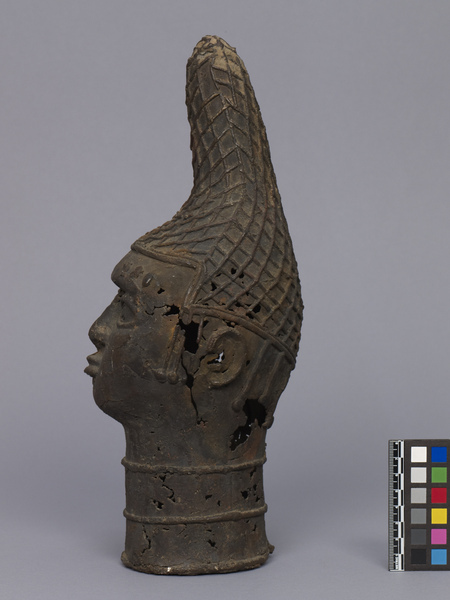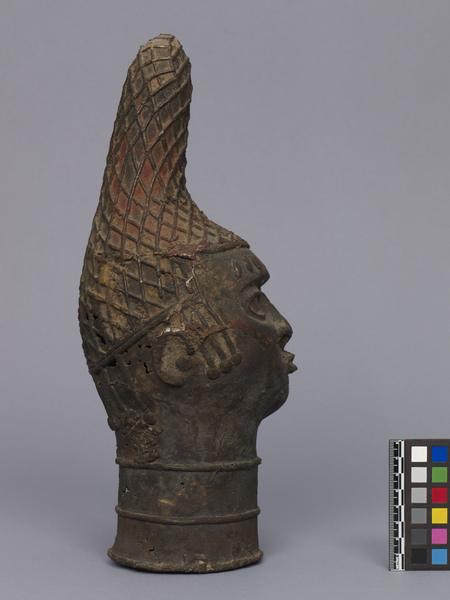Queen Mother Head Sculpture Item Number: 2853/6 from the MOA: University of British Columbia




Description
Cast bronze, hollow female head. The face has a pronounced brow with three small protruding marks above each eye, possibly representing scarification. Below the slightly protruding lips is a shallow jaw line leading to a long neck which is decorated with three thin rings. On the head is an elaborate headdress or hairstyle, starting at the hair line and culminating in a tall, thin cone-shaped projection at the top of the head that curves slightly forward. It is decorated with angled lines that are raised and crossed, making a diamond pattern. Decorations attached to the headdress hang down in front of the ears and at the back of the neck. The inside of the head is hollow and has a wire hanging halfway down from the point of the headdress.
History Of Use
Head figures were used to commemorate the dead, and the materials used represented different types of individuals being commemorated. Bronze heads were produced by the royal guild of bronze casters, and they were made for a member of the court. Terracotta heads were used by bronze casters to commemorate their own ancestors, while chiefs used wood. The memorial head tradition became significant in the 16th century, and over time they became more stylistic and elaborate. This type of bronze figure portrays queen mothers of the Benin royal family. Referred to as Iyoba – Queen Mother – these memorials are one of the few historical depictions of women in Benin. Iyoba as representation emerged when Queen Idia, the mother of Oba (King) Esigie who ruled 1504–1550, defended her position as a member of the royal court. She began a tradition of queen mothers being memorialized through commemorative bronze castings for ancestral veneration.
Narrative
Marcel Ollivier was the French Consul General posted to Freetown, Sierra Leone, c. 1960s-1970, during which time he purchased this collection of objects (2853/1-9). He later finished his diplomatic service in Vancouver as French Consul General from 1982-1986, after which he retired to England. The objects were donated to MOA at the specific request of Ollivier, via his daughter-in-law.
Specific Techniques
Made with the cire-perdue or lost-wax method. The mould is made of beeswax, covered with clay, and then fired. The wax melts and the hollow clay cast is then filled with scraps of copper-based alloy, before being fired for a second time. XRF analysis suggests the piece is made of leaded gunmetal (also called 'red brass' - a bronze alloy), with a high bismuth content.
Item History
- Made in Benin City, Edo, Nigeria ?
- Collected between 1960 and 1970
- Owned by Marcel Ollivier
- Owned by Janna Kirkwood before December 9, 2010
- Received from Janna Kirkwood (Donor) on December 9, 2010
What
- Name
- Queen Mother Head Sculpture
- Identification Number
- 2853/6
- Type of Item
- sculpture
- Material
- bronze metal
- Overall
- height 34.0 cm, width 12.3 cm, depth 13.5 cm
Who
- Culture
- Edo ?
- Previous Owner
- Marcel Ollivier and Janna Kirkwood
- Received from
- Janna Kirkwood (Donor)
Where
- Holding Institution
- MOA: University of British Columbia
- Made in
- Benin City, Edo, Nigeria ?
When
- Collection Date
- between 1960 and 1970
- Ownership Date
- before December 9, 2010
- Acquisition Date
- on December 9, 2010
Other
- Item Classes
- metalwork
- Condition
- fair
- Accession Number
- 2853/0006